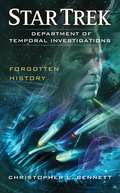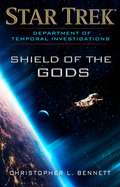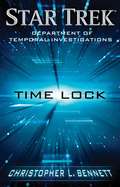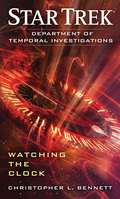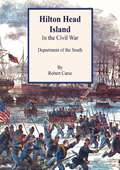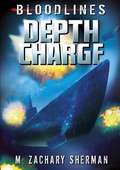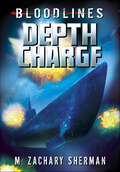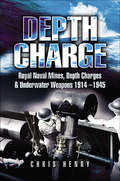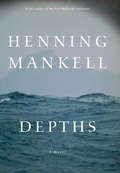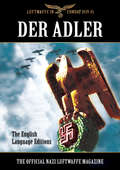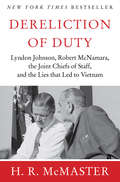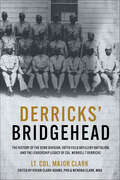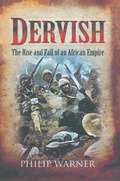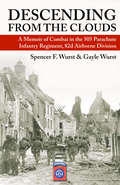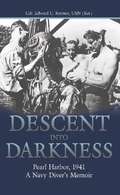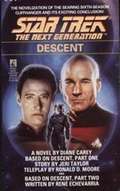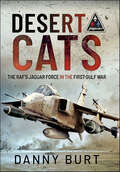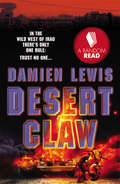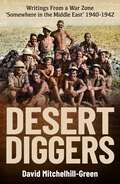- Table View
- List View
Department of Temporal Investigations: Forgotten History (Star Trek)
by Christopher L. BennettThe agents of the Department of Temporal Investigations are assigned to look into an anomaly that has appeared deep in Federation territory. It’s difficult to get clear readings, but a mysterious inactive vessel lies at the heart of the anomaly, one outfitted with some sort of temporal drive disrupting space-time and subspace. To the agents’ shock, the ship bears a striking resemblance to a Constitution-class starship, and its warp signature matches that of the original Federation starship Enterprise NCC-1701—the ship of James T. Kirk, that infamous bogeyman of temporal investigators, whose record of violations is held up by DTI agents as a cautionary tale for Starfleet recklessness toward history. But the vessel’s hull markings identify it as Timeship Two, belonging to none other than the DTI itself. At first, Agents Lucsly and Dulmur assume the ship is from some other timeline . . . but its quantum signature confirms that it came from their own past, despite the fact that the DTI never possessed such a timeship. While the anomaly is closely monitored, Lucsly and Dulmur must search for answers in the history of Kirk’s Enterprise and its many encounters with time travel—a series of events with direct ties to the origins of the DTI itself. . . .
Department of Temporal Investigations: Shield of the Gods (Star Trek: Deep Space Nine)
by Christopher L. BennettAn all new Star Trek e-novella featuring the fan-favorite Federation bureau the Department of Temporal Investigations!The stalwart agents of the Department of Temporal Investigations have tracked down many dangerous artifacts, but now they face a greater, more personal challenge: retrieving a time-travel device stolen from their own vault by a rogue agent of the Aegis, a powerful, secretive group that uses its mastery of time to prevent young civilizations from destroying themselves. Blaming the Aegis itself for a tragedy yet to come, this renegade plans to use the stolen artifact to sabotage its efforts in the past, no matter what the cost to the timeline. Now the DTI’s agents must convince the enigmatic Aegis to work alongside them in order to protect history—but they must also wrestle with the potential consequences of their actions, for preserving the past could doom countless lives in the future!
Department of Temporal Investigations: Time Lock (Star Trek: Deep Space Nine)
by Christopher L. BennettAn all new Star Trek e-novella from the world of Deep Space Nine, featuring the fan-favorite Federation bureau the Department of Temporal Investigations!The dedicated agents of the Federation Department of Temporal Investigations have their work cut out for them protecting the course of history from the dangers of time travel. But the galaxy is littered with artifacts that, in the wrong hands, could threaten reality. One of the DTI's most crucial jobs is to track down these objects and lock them safely away in the Federation’s most secret and secure facility. As it happens, Agent Gariff Lucsly and his supervisor, DTI director Laarin Andos, are charged with handling a mysterious space-time portal device discovered by Starfleet. But this device turns out to be a Trojan horse, linking to a pocket dimension and a dangerous group of raiders determined to steal some of the most powerful temporal artifacts ever known...
Department of Temporal Investigations: Watching the Clock (Star Trek)
by Christopher L. BennettThere’s likely no more of a thankless job in the Federation than temporal investigation. While starship explorers get to live the human adventure of traveling to other times and realities, it’s up to the dedicated agents of the Federation Department of Temporal Investigations to deal with the consequences to the timestream that the rest of the Galaxy has to live with day by day. But when history as we know it could be wiped out at any moment by time warriors from the future, misused relics of ancient races, or accident-prone starships, only the most disciplined, obsessive, and unimaginative government employees have what it takes to face the existential uncertainty of it all on a daily basis . . . and still stay sane enough to complete their assignments. That’s where Agents Lucsly and Dulmur come in—stalwart and unflappable, these men are the Federation’s unsung anchors in a chaotic universe. Together with their colleagues in the DTI—and with the help and sometimes hindrance of Starfleet’s finest—they do what they can to keep the timestream, or at least the paperwork, as neat and orderly as they are. But when a series of escalating temporal incursions threatens to open a new front of the history-spanning Temporal Cold War in the twenty-fourth century, Agents Lucsly and Dulmur will need all their investigative skill and unbending determination to stop those who wish to rewrite the past for their own advantage, and to keep the present and the future from devolving into the kind of chaos they really, really hate.
Department of the South: Hilton Head Island in the Civil War
by Robert CarseStep back into the tumultuous era of the American Civil War with Robert Carse's Department of the South: Hilton Head Island in the Civil War. This compelling historical account delves into the strategic importance of Hilton Head Island, a vital Union stronghold and headquarters for the Department of the South. Carse meticulously chronicles the island's transformation from a quiet Southern community to a bustling military hub, shedding light on the lives of soldiers, freed slaves, and residents whose worlds were forever changed by the war.Through detailed narratives and vivid illustrations, Carse brings to life the battles, skirmishes, and daily challenges faced by those stationed on Hilton Head Island. Readers will explore the military strategies, leadership decisions, and logistical efforts that made the island a critical base for Union operations in the South. The book also provides a poignant look at the human side of war, capturing the resilience, hardships, and moments of hope experienced by the people who lived through this defining period in American history.Department of the South is a must-read for Civil War enthusiasts, historians, and anyone interested in the rich tapestry of America's past. Carse's engaging storytelling and thorough research offer a profound understanding of Hilton Head Island's pivotal role in the Civil War, making this book an essential addition to any history lover's collection.
Deployment Experiences of Guard and Reserve Families: Implications for Support and Retention
by Margaret C. Harrell Danielle M. Varda Megan K. Beckett Laura Werber Kimberly Curry HallUse of the Reserve Component has steadily increased since the 1990s, but little research has focused on how deployment affects guard and reserve families. This monograph presents the results of interviews with reserve component personnel and spouses, focusing on their deployment experiences and military career intentions. The authors conclude with suggestions on how the Department of Defense can better support guard and reserve families.
Depth Charge (Bloodlines)
by M. Sherman Raymund Bermudez Raymund LeeWhen British Intelligence learns of a German U-Boat anchored off the coast of Sweden, in neutral waters, they enlist the help of an American Naval code-breaking officer to go undercover as Nazis. Their mission: sneak aboard the German sub and liberate the Enigma decoding machine.
Depth Charge (Bloodlines)
by M. Zachary ShermanWhen British Intelligence learns of a German U-Boat anchored off the coast of Sweden, in neutral waters, they enlist the help of an American Naval code-breaking officer to go undercover as Nazis. Their mission: sneak aboard the German sub and liberate the Enigma decoding machine.
Depth Charge: Royal Naval Mines, Depth Charges & Underwater Weapons, 1914–1945
by Chris HenryThe history of weapons and warfare is usually written from the point of view of the battles fought and the tactics used. In naval warfare, in particular, the story of how these weapons were invented, designed and supplied is seldom told. Chris Henry, in this pioneering study, sets the record straight. He describes how, to counter the extraordinary threat posed by the U-boats in the world wars, the Royal Navy responded with weapons that kept open the vital supply routes of the Atlantic Ocean.He also celebrates the remarkable achievements of the engineers and inventors whose inspired work was essential to Britain's survival.
Depths: A Novel
by Henning MankellThe master of Scandinavian crime fiction spins a dark tale of passion and deceit set during World War I: &“A memorable and shocking psychological study&” (Publishers Weekly). October, 1914. Swedish naval officer Lars Tobiasson-Svartman is charged with a secret mission to take depth readings around the Stockholm archipelago. In the course of his work, he lands on the rocky isle of Halsskär. It seems utterly inhabitable, yet Halsskär is home to the young widow Sara Fredrika. Lars soon learns that Sara, living in near-total isolation, is unaware that the world is at war. A man of control and precision, Lars is overwhelmed by his attraction to the half-wild, illiterate Sara, a total contrast to his reserved, elegant wife. Giving in to the worst of his impulses, Lars turns into a far more dangerous man—one ready to trade in lies and even death to get closer to the lonely woman without losing hold of his wife. All thoughts of shame, fidelity, and duty are swept to sea as he struggles to maintain his parallel lives, with devastating consequences for the women who love him. Henning Mankell, author of the internationally bestselling Kurt Wallander Mysteries and the critically acclaimed Chronicler of the Winds, once again proves himself a master of the novel with this arresting, disquieting story of obsession.
Der Adler: The Official Nazi Luftwaffe Magazine: The English Language Editions (Luftwaffe in Combat 1939–45)
by Bob CarruthersDer Adler was the official magazine of the Luftwaffe in World War II. In the years before Hitler declared war on America an English language edition of Der Adler costing eight cents was published and widely sold in the USA. The magazine was available on American news stands and the surviving English language editions provide readers who do not speak German with a fascinating primary source from inside the Third Reich. The magazine was at its best and most interesting during the years of German ascendancy between 1940 and 1942. From that point onwards the Luftwaffe had less and less to celebrate and Der Adler tended to concentrate on the exploits of the Luftwaffe ground forces especially the burgeoning Falshirmjaeger divisions. This selection of the best of the English language articles from Der Adler provides a privileged glimpse inside the Luftwaffe during its years of triumph between 1940 and 1942.
Der Finsternis vertrauen
by Eva Fairwald Kay-Viktor StegemannEs ist keine Schande, das Leben dem Tod vorzuziehen - Captain Ella Dorsh ist zäh, kompetent und ... sitzt in der Tinte. Sie ist ziemlich sicher, dass der Feind das Spiel bestimmt und dass der Krieg sehr bald die Oberfläche erreicht, aber die Menschen sind noch nicht so weit. Das Unterreich ist verarmt und seine Bevölkerung aus Dunkelelfen will die Welt erobern und beherrschen. Ella und die Divisionen der "Wiedergeborenen" sind die einzige echte Chance, den Feind auf Augenhöhe zu bekämpfen: Elfen gegen Elfen, um wertvolle Menschenleben zu schonen. Doch so einfach wie es scheint ist hier gar nichts, und die Finsternis verbirgt mehr, als Ella sich je vorstellen konnte. Die Geschichte spielt in unserer Welt in einer nahen Zukunft. Sie hat einige Science-Fiction- und dystopische Elemente und eine starke weibliche Heldin, die dich umhauen wird! Dieser Roman handelt von Elfensoldaten, die in etwas Unentrinnbares hineingezogen werden, und von gefährlichen Geheimnissen, die das Leben und die Geschichte für immer verändern.
Der Mensch spiegelt sich im Blick der Tiere: Auflösung und Neudefinition des Menschen in der Exilliteratur (Exil-Kulturen #9)
by Carla SwiderskiWas ist der Mensch und wie verhält er sich zum Tier? Wird diese Frage in ethischen, gesellschaftlichen, philosophischen und ästhetischen Diskursen seit der Antike debattiert, stellt sie sich im 20. Jahrhundert angesichts der NS-Diktatur und ihrer Verbrechen gegen die Menschlichkeit in einem besonders bedrohlichen Umfeld. Wie wirkt sich dies auf das nachfolgende Verständnis von Mensch und Tier aus? – Die vorliegende Arbeit untersucht Mensch-Tier-Konstellationen in fiktionalen und theoretischen Texten, die im durch das NS-Regime verursachten Exil entstanden sind. Dabei werden Fragen der Exilforschung mit Fragen der Literary und Cultural Animal Studies zusammengedacht. Ausführlich analysiert werden Texte von Victor Klemperer, Alexander Bein, Hannah Arendt, Max Horkheimer und Theodor W. Adorno, Hermann Broch, Oskar Maria Graf, Alfred Kerr, Hilde Domin und Hans Sahl.
Der unvergessliche Zweite Weltkrieg: Die Folgen eines beispiellosen Krieges
by Scott S. F. Meaker Dennis TraubDies ist ein kurzes Buch über die Folgen des Zweiten Weltkrieges Kriege hatten schon immer immense Auswirkungen auf die sozialen und ökonomischen Grundlagen eines Landes. Durch seine nie dagewesene, flächendeckende Zerstörung hat der Zweite Weltkrieg erstmals auch das Konzept der Familie völlig zerrissen. Dieses Buch beleuchtet die Erfahrungen der Menschen in sechs ganz unterschiedlichen Regionen, die in diesen globalen Konflikt verwickelt waren - und die Folgen dieses unvergesslichen Krieges.
Dereliction of Duty: Johnson, McNamara, the Joint Chiefs of Staff
by H. R. Mcmaster"The war in Vietnam was not lost in the field, nor was it lost on the front pages of the New York Times or the college campuses. It was lost in Washington, D.C." - H. R. McMaster (from the Conclusion) Dereliction Of Duty is a stunning new analysis of how and why the United States became involved in an all-out and disastrous war in Southeast Asia. Fully and convincingly researched, based on recently released transcripts and personal accounts of crucial meetings, confrontations and decisions, it is the only book that fully re-creates what happened and why. It also pinpoints the policies and decisions that got the United States into the morass and reveals who made these decisions and the motives behind them, disproving the published theories of other historians and excuses of the participants. Dereliction Of Duty covers the story in strong narrative fashion, focusing on a fascinating cast of characters: President Lyndon Johnson, Robert McNamara, General Maxwell Taylor, McGeorge Bundy and other top aides who deliberately deceived the Joint Chiefs of Staff, the U.S. Congress and the American public. Sure to generate controversy, Dereliction Of Duty is an explosive and authoritative new look at the controversy concerning the United States involvement in Vietnam.
Dereliction of Duty: The Eyewitness Account of How Bill Clinton Compromised America's National Security
by Robert B. PattersonIt is argued that Clinton was much more interested in himself than in his Nation.
Derricks' Bridgehead: The History of the 92nd Division, 597th Field Artillery Battalion, and the Leadership Legacy of Col. Wendell T. Derricks
by Lt. Col. ClarkFinalist, 2023 Army Historical Foundation Distinguished Writing Awards"[The author] saw firsthand the unit's hardships and setbacks, but also its successes and victories. His brings this direct knowledge to bear in this detailed and fascinating look at the experiences of African American military units during the war."— WWII History Magazine The 597th Field Artillery Battalion, 92nd Division, was the first, last, and only all-black officered direct support field artillery battalion committed to combat in the history of the U.S. Army. It was the first all-black unit in a combat division and, together with the 600th Field Artillery Battalion, constituted the only all-black units in any combat division. Alongside impressive achievements on the battlefield in Italy in 1944–45, the unit provided more key command and staff positions exclusively for black field artillery officers than any other U.S. Army unit in combat, giving combat training and experience to more senior black field artillery officers than any of the other 16 black field artillery battalions during World War II. Colonel Wendell Derricks worked to shelter his troops from the worst of the racism exhibited during the war and, due to his ability to envision an integrated postwar army, he provided unique leadership opportunities for his senior officers. The alumni of the 597th Field Artillery Battalion have an impressive record of success, many of them were inducted into the Field Artillery Hall of Fame; some served at the Pentagon, including Lieutenant Colonel Clark; and others forged successful careers in the civilian world.
Dervish: The Rise and Fall of an African Empire (Wordsworth Military Library)
by Philip WarnerDervish is the vivid and colourful story of one of the more remarkable episodes in the high Empire period of British history. The Mahdis rising in the Sudan in the 1880s starting as a localized Holy War against the decadent Turkish/Egyptian overlords, engulfed a million square miles of arid territory and forced the British Liberal Government to get involved after the early disasters of the Hicks expedition and Gordons death at Khartoum.The narrative, which makes excellent use of the first-hand diaries and reports, including those of Rider Haggards brother Andrew and of Father Ohrwalder (the Austrian missionary who spent ten years of captivity in the Mahdis camp), brilliantly describes the growth and strength of the Mahdist movement and the extraordinary devotion and discipline of the Dervish troops. Facing such opponents with stoic endurance were the British, Egyptian and Sudanese Negro soldiers, and the resulting military engagements evoked amazing feats of courage and derring-do on both sides.The Dervish Empire outlasted the Mahdi by thirteen years. It ended in the battle of Omdurman and Kitcheners reconquest of the Sudan, which was well supported by Reginald Wingates military intelligence operations. It lasted a comparatively brief span of time, but it had been established at the expense not only of the neighbouring Abyssinians but also of the European white man, at a time when Britain was approaching the zenith of its imperial power.Philip Warner is author of Passchendale and The Zeebrugge Raid and numerous other first rate histories. He wrote the biographies of Auchinleck and Horrocks. He was the military obituary writer of The Daily Telegraph for many years. In WW2 he was a POW of the Japanese for 1,000 days. He died in 2000.
Descending from the Clouds
by Gayle Wurst Spencer F. WurstWearing the remnants of a WWI uniform and pulling a water-cooled 30-caliber machine-gun, Spencer Wurst marched through his hometown of Erie, Pennsylvania, in 1940 as a member of the National Guard. He was 15 years old. Five years later he was a hardened platoon sergeant leading his troopers through the frozen killing fields of "Death Valley" in Germany's Heurtgen Forest. A squad leader in Company F, 505 Parachute Infantry Regiment, 82d Airborne, for most of the war, Wurst jumped into Italy in September 1943, and received his baptism of fire at Arnone. Jumping into Normandy on D-Day, he received his first Purple Heart in the liberation of Ste. Mère-Eglise, and a second Purple Heart in grueling combat through the hedgerows. On his third jump, Wurst's bravery under fire earned him the coveted Silver Star when he and his fellow paratroopers were swept up in the ferocious battle with the SS for the Highway Bridge at Nijmegen, Holland, in Operation Market Garden. A few months later, the dawn of his twentieth birthday found him serving on point in the long, freezing march to the shoulder of the Bulge. A unique view of combat from pre-war training and mobilization to First Army maneuvers, parachute school at Fort Benning, and Europe's killing fields, Wurst's poignantly written and carefully researched memoir has been hailed as an outstanding addition to the literature of WWII.
Descent into Darkness
by USN Edward C. RaymerOn December 7, 1941, as the great battleships Arizona, Oklahoma, and Utah lie paralyzed and burning in the aftermath of the Japanese attack on Pearl Harbor, a crack team of U.S. Navy salvage divers headed by Edward C. Raymer are hurriedly flown to Oahu from the mainland. The divers have been given a Herculean task: rescue the sailors and Marines trapped below, and resurrect the pride of the Pacific fleet.Now for the first time, the chief diver of the Pearl Harbor salvage operations, Cmdr. Edward C. Raymer, USN (Ret.), tells the whole story of the desperate attempts to save crewmembers caught inside their sinking ships. Descent into Darkness is the only book available that describes the raising and salvage operations of sunken battleships following the December 7th attack.Once Raymer and his crew of divers entered the interiors of the sunken shipwrecks-attempting untested and potentially deadly diving techniques-they experienced a world of total blackness, unable to see even the faceplates of their helmets. By memorizing the ships' blueprints and using their sense of touch, the divers groped their way hundreds of feet inside the sunken vessels to make repairs and salvage vital war material. The divers learned how to cope with such unseen dangers as falling objects, sharks, the eerie presence of floating human bodies, and the constant threat of Japanese attacks from above.Though many of these divers were killed or seriously injured during the wartime salvage operations, on the whole they had great success performing what seemed to be impossible jobs. Among their credits, Raymer's crew raised the sunken battleships USS West Virginia, USS Nevada, USS California, After Pearl Harbor they moved on to other crucial salvage work off Guadalcanal and the sites of other great sea battles.
Descent: Descent (Star Trek: The Next Generation)
by Diane CareyThe Borg are back -- and nastier than ever. No longer mindless, inhuman drones but cyborg soldiers on a mission to assimilate all intelligent life, their new goal is the complete destruction of the Federation. And in the midst of facing the Borg again, Captain Picard learns that he may be the cause of the change. Commander Data is changing as well. For the first time in his life, Data feels a genuine emotion -- and that emotion is deadly, destructive rage. When it is revealed that the Borg are commanded by an old enemy out of Data's past, Data must choose between his allegiance tot he Federation and the one thing he wants above all else...
Description and Analysis of the VA National Formulary
by Institute of MedicineThe National Academies Press (NAP)--publisher for the National Academies--publishes more than 200 books a year offering the most authoritative views, definitive information, and groundbreaking recommendations on a wide range of topics in science, engineering, and health. Our books are unique in that they are authored by the nation's leading experts in every scientific field.
Desert Cats: The RAF's Jaguar Force in the First Gulf War
by Danny BurtOn 2 August 1990, Saddam Hussein’s armed forces invaded and occupied Kuwait. A swift international response followed, which, led by the United States and the United Kingdom, saw the formation of a coalition that formed the largest military alliance seen since the end of the Second World War. Among the many RAF units deployed under Operation Granby, the codename given to the British military operations during the conflict, was 41 Squadron, with elements taken from 54 Squadron and 226 OCU, which was equipped with the ubiquitous Jaguar GR1 single-seat all-weather tactical strike and ground-attack fighter. In late 1990, the squadron duly despatched a total of twelve aircraft, which soon became known for their distinctive desert pink camouflage, and twenty-two pilots from their base at RAF Coltishall. Initially conducting low-level strikes, for which the Jaguar Force had always been intended, over the weeks that followed 41 Squadron switched to more unusual medium-level missions. In total, the men and machines of 41 Squadron conducted a total of 617 sorties during Operation Granby. To complete this remarkable description of 41 Squadron’s part in the liberation of Kuwait, the author has interviewed a number of these pilots. As well as these veterans’ personal reflections, Danny Burt also explores the Jaguars’ record on air-to-ground combat and its performance in theatre, the various upgrades the type receive, and the unique nose art that each aircraft carried. Many of the pictures in this highly illustrated publication have never been published before. The story is completed by the recovery by the author of one of the Jaguar GR1s flown in the Gulf WarRescued from an Army range in South Wales, the aircraft was moved to RAF Coningsby where its restoration, including the return of its Operation Granby camouflage, is underway.
Desert Claw
by Damien LewisIraq: the present day. A country torn apart by war and anarchy. Thieves roam the streets. People are being killed in broad daylight. Security is non-existent. And now, terrorists have seized a Van Gogh painting worth £25 million from one of Saddam's palaces. They are offering it to the highest bidder. The painting's original owner, a Kuwaiti prince, from whom it was seized during Iraq's occupation of Kuwait in the First Gulf War, has asked for HMG's help in retrieving it. The British Government owes him a favour for backing them during the Iraq War, so they agree to help. But rather than agreeing to pay the terrorists' ransom -- which they fear will be pumped into funding terrorist operations across the world -- HMG decides to send in a team of hardened ex-Special Forces, led by ex-SAS hero Mick Kilbride and his sidekick 'East End' Eddie. Sent undercover in a deniable operation called Desert Claw, their brief is simple: retrieve the painting, and eliminate the terrorists at the earliest possible opportunity. The mission sounds simple enough. But as Mick and his team are drawn into a dark and violent world, things are not always as they seem. And in the final climactic scene, a horrible and shocking truth awaits for the men.
Desert Diggers: Writings From a War Zone 'Somewhere in the Middle East' 1940-1942
by David Mitchelhill-GreenDesert Diggers: Writings from a War Zone &‘Somewhere in the Middle East&’ 1940-1942 draws upon hundreds of soldiers&’ letters in a fresh and captivating narrative of the war in North Africa. Desert Diggers follows the first men to volunteer after the outbreak of war in 1939, tracing their adventures in exotic ports before further training in Palestine. A hunger for action grew: &‘Most of the chaps are ... anxious to get into anything that looks like a fight&’, one soldier wrote to his brother. From Egypt, &‘the hottest and dustiest place on God's earth&’ was the Diggers&’ next destination and their &‘blooding&’ in the battles for Bardia and Tobruk. After Rommel failed to storm Tobruk in April-May 1941, Nazi propaganda denigrated the garrison, &‘caught like rats in a trap&’. Amid frequent bombing and shelling, Berlin&’s scornful broadcasts were an unintended tonic. &‘Frequently we laughed and joked until the tears came into our eyes&’, a Digger quipped. From Tobruk, to the blunting of Rommel&’s attacks at El Alamein, the price of victory was palpably high: &‘some of my best mates didn't come out of it&’, lamented a corporal to his sister. Returning to Australia in 1943, some men maimed or traumatised, brought a further test for the Diggers ...Told in the words of the men who served, Desert Diggers offers a new personal perspective on the Western Desert campaign. With immediacy and raw emotion, these skillfully woven letters provide a remarkable and compelling account of the Australian experience of war.
